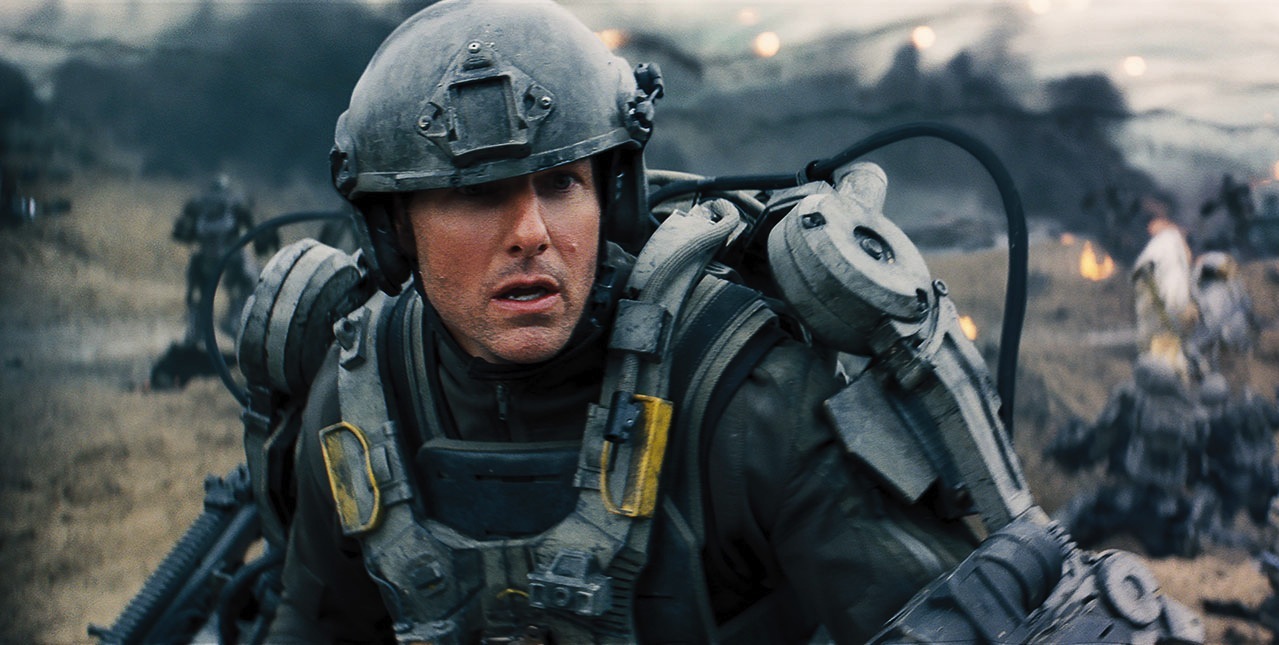
Edge of Tomorrow – Warner Brothers
“Courage is not simply one of the virtues but the form of every virtue at the testing point.”
– C.S. Lewis
When audiences first meet Tom Cruise’s character (Bill Cage) in Edge of Tomorrow, he’s cocky, weak, and selfish. With a background in advertising, Cage has risen through the ranks of the United States military, using charm and charisma to boost enlistments in a war against an extraterrestrial force engulfing Europe. Cage has never seen battle, but he is a salesman. And, like any good salesman, Cage pushes a product: the army’s new exoskeleton combat suit. A suit that promises to transform even those with limited military experience into alien-slaying machines.
In a twist of irony, Cage is assigned, against his will, to fight with the first wave of soldiers in a Normandy-style invasion. Anxious, incompetent, unprepared, Cage is killed in battle right as he’s soaked in a spew of alien blood. For reasons the audience becomes privy to later, Cage wakes up the day before the invasion, made to relive the last twenty-four hours again. And again. And again.
Caught in what I can only compare to a extra long animated gif, Cage enlists the help of Rita Vrataski (Emily Blunt), a war hero who once experienced her own version of Groundhog Day. Through a montage of training sessions, “Choose Your Own Adventure” sketches, and a budding (though obviously one-sided) relationship between the unlikely couple, Cage slowly morphs into an unparalleled super-soldier bent on destroying earth’s uninvited houseguests.
I think it’s important for me to say here that I probably shouldn’t have liked Edge of Tomorrow. The story falls into a few overdone alien invasion clichés, leading up to one decisive solution rather than a more realistic (if it’s safe to say realistic when talking about alien invasions) war of attrition. A few of the key plot points are too convenient (I know it’s science-fiction, but help me out here!). And then there’s that one scene—if you’ve watched the film you know which one I’m talking about.
But—and that’s a big but—I couldn’t help but enjoy Edge of Tomorrow. It’s funny, paces well, and has some of the best alien designs in recent years. It’s tense too. With a story involving the lead character endlessly respawning in the same position each day, you’d imagine a fairly low viewer buy-in. The opposite is true. Tomorrow’s plot is structured in such a way that the audience isn’t as much worried about Cage dying during his endless loop, as they are about him eventually living through it. And this works; thanks partially (or mostly) to Cruise and Blunt’s stellar performances.

Tom Cruise and Emily Blunt in Edge of Tomorrow – Warner Brothers
Blunt’s Vrataski is as tough as she is emotionally guarded. She becomes a catalyst that inspires change in Cage—both inside and out. Yet, she’s never reduced to a simple plot point or motivational tool. Blunt is the essence of a strong, powerful, can-hold-her-own, female character. She’s naturally attractive, but not over-sexualized. A love interest, but not simply a love interest. She’s the opposite of Alice Eve’s Carol Marcus in last year’s Star Trek Into Darkness; a character content to hang around as eye-candy—taking off her clothes for no reason. Above all, Blunt is just really interesting.
This is not to say she overshadows Cruise, who is one of our greatest action stars today. As the story marches forward, Cage begins a gradual transformation from salesman to soldier. At the beginning of Edge of Tomorrow, sacrifice is someone else’s responsibility. Cage lives the ultimate hypocrisy, pushing soldiers into combat while doing everything (including blackmail) to avoid it himself. Then, as he’s allowed to view his life through every minor detail of a single day, Cage develops something. Courage. He begins to take risks. His journey as a character takes him through heartache, despair, and apathy. Yet, he emerges stronger than he was before.
C.S. Lewis wrote, “Courage is not simply one of the virtues but the form of every virtue at the testing point.” It’s no wonder that as Cage develops courage, he also develops love, strength, and empathy toward others.
This quality is what makes Edge of Tomorrow a good film versus an average film. Because, in some small way, we as an audience can relate to Cage. We can relate to perpetuating the false idea that personal sacrifice is someone else’s responsibility. We become the ultimate hypocrites when we call for self-denial, but are unwilling to make those changes ourselves. This point touches on everyone; senators, pastors, teachers, voters. Are we willing to be as courageous as we ask someone else to be? Bill Paxton’s character tells Cage each day that, “battle is the great redeemer;” it will “baptize” him. Through combat he will be “born again.” In the content of the story, there’s a sense of truth to his words. Cage’s “battle,” the development of courage, will ultimately be his redemption. In a sense he is “born again”—both literally and figuratively—learning with each new birth the importance of sacrifice and humility.
Edge of Tomorrow takes a slightly different route than the somewhat similar Groundhog Day, but the emphasis on character transformation remains the same. It is only by being “baptized” and “born again” that one will leave the endless field of battle and truly experience life. Yet, while Bill Murray’s looping sentence in the classic 1993 film serves as a purgatory of sorts, Cage’s struggle is primarily about the greater good. The greater sanctification. He must harness the strength to not only think less of himself, but also learn to trust, love, and rely on others.
4 1/2 Stars out of 5
Edge of Tomorrow is rated PG-13 for intense sequences of sci-fi action and violence, language and brief suggestive material.




